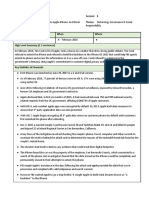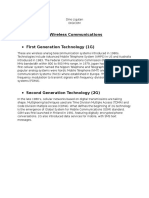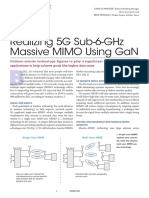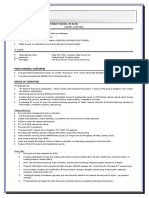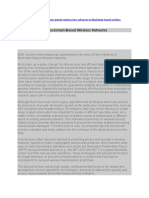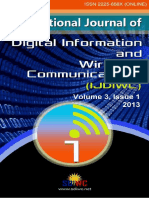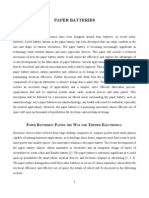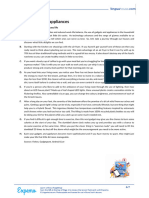0 ratings0% found this document useful (0 votes)
42 viewsTelecom Industry
Telecom Industry
Uploaded by
smart telugu guruThe telecommunications industry plays a crucial role in evolving mobile communications and the information society. 5G is expected to have a big impact once rolled out by providing speeds 100 times faster than 4G and replacing home internet connections. However, fully realizing 5G comes with challenges around using new higher frequency bands that have limited penetration, extensive deployment and coverage that requires more infrastructure, high costs to build out the network, and ensuring security and privacy as data usage increases.
Copyright:
© All Rights Reserved
Available Formats
Download as PPTX, PDF, TXT or read online from Scribd
Telecom Industry
Telecom Industry
Uploaded by
smart telugu guru0 ratings0% found this document useful (0 votes)
42 views9 pagesThe telecommunications industry plays a crucial role in evolving mobile communications and the information society. 5G is expected to have a big impact once rolled out by providing speeds 100 times faster than 4G and replacing home internet connections. However, fully realizing 5G comes with challenges around using new higher frequency bands that have limited penetration, extensive deployment and coverage that requires more infrastructure, high costs to build out the network, and ensuring security and privacy as data usage increases.
Original Title
Telecom Industry.pptx
Copyright
© © All Rights Reserved
Available Formats
PPTX, PDF, TXT or read online from Scribd
Share this document
Did you find this document useful?
Is this content inappropriate?
The telecommunications industry plays a crucial role in evolving mobile communications and the information society. 5G is expected to have a big impact once rolled out by providing speeds 100 times faster than 4G and replacing home internet connections. However, fully realizing 5G comes with challenges around using new higher frequency bands that have limited penetration, extensive deployment and coverage that requires more infrastructure, high costs to build out the network, and ensuring security and privacy as data usage increases.
Copyright:
© All Rights Reserved
Available Formats
Download as PPTX, PDF, TXT or read online from Scribd
Download as pptx, pdf, or txt
0 ratings0% found this document useful (0 votes)
42 views9 pagesTelecom Industry
Telecom Industry
Uploaded by
smart telugu guruThe telecommunications industry plays a crucial role in evolving mobile communications and the information society. 5G is expected to have a big impact once rolled out by providing speeds 100 times faster than 4G and replacing home internet connections. However, fully realizing 5G comes with challenges around using new higher frequency bands that have limited penetration, extensive deployment and coverage that requires more infrastructure, high costs to build out the network, and ensuring security and privacy as data usage increases.
Copyright:
© All Rights Reserved
Available Formats
Download as PPTX, PDF, TXT or read online from Scribd
Download as pptx, pdf, or txt
You are on page 1of 9
Telecommunication industry
The telecommunications industries within the sector of
information and communication technology is made up
of all telecommunications/telephone companies and
internet service providers and plays the crucial role in
the evolution of mobile communications and the
information society.
5G
• It’s expected that 5G, the much-discussed upcoming broadband
cellular mobile communications standard, will have a big impact
once the network rollout is here.
• The speed and bandwidth of 5G would be such that it could
effectively replace home internet connections currently using Wi-
Fi. The Consumer Technology Association has reported that 5G
will reach speeds of 10 Gbps, making it 100 times faster than 4G.
This means that a two-hour movie that would take six minutes to
download on 4G, would take less than four seconds to download
on 5G.
• Making it a reality comes with some challenges along the way.
Here are five that will figure prominently throughout the process.
Frequency bands
•
Though 4G LTE already operates on established frequency
bands below 6GHz, 5G requires frequencies — all the way
up to 300GHz. Some are better known as mmWave. Those
bands can carry far more capacity and deliver ultra-fast
speeds that deliver a 20-fold increase over LTE’s fastest
theoretical throughput.
• Most cellular “5G frequencies” (higher frequencies)
cannot even penetrate a piece of glass. 95% of
cellular 5G frequencies are up to 100x worse
at penetrating walls, glass, and buildings.
Deployment and coverage
•
Despite 5G offering a significant increase in speed and bandwidth, its more limited
range will require further infrastructure. Higher frequencies enable highly directional
radio waves, meaning they can be targeted or aimed — a practice called beamforming.
The challenge is that 5G antennas, while able to handle more users and data, beam
out over shorter distances.
• Even with antennas and base stations getting smaller in this scenario, more of them
would likely have to be installed on buildings or homes. Cities will probably need to
install extra repeaters to spread out the waves for extended range, while also
maintaining consistent speeds in denser population areas. It’s likely carriers will
continue to use lower-frequency bands to cover wider areas until the 5G network
matures.
• In the future, it may mean that modems and Wi-Fi routers are replaced with 5G small
cells or other hardware to bring 5G connections into homes and businesses, thus
doing away with wired internet connections as we know them today. Spreading out
access to rural areas will be as much of a challenge as it was with LTE.
Cost to build, cost to buy
•
Building a network is expensive, and carriers will raise the
money to do it by increasing customer revenue. Much like LTE
plans incurred a higher initial cost, 5G will probably follow a
similar path. And it’s not just building a layer on top of an
existing network — it’s laying the groundwork for something
new altogether.
• According to Heavy Reading’s Mobile operation of 5g Capex,
total global spending on 5G is set to reach $88 billion by 2023.
Once it becomes truly viable, certain device segments will be
connected in entirely new ways, particularly vehicles,
appliances, robots and city infrastructure.
Regulations and standards
• Government regulators will figure into 5G
deployment, particularly with the additional
infrastructure required to spread out the network.
Providers will need to install new antennas, base
stations and repeaters.
• Beyond that, regulators will need to tackle 5G
services in waves across multiple vertical sectors.
These can include spectrum availability, EMF
radiation regulations, infrastructure sharing, and
cybersecurity.
Security and privacy
This would be a challenge with any data-driven
technology, but the 5G rollout will have to contend
with both standard and sophisticated cybersecurity
threats. Though 5G falls under the Authentication and
Key Agreement (AKA), a system designed to establish
trust between networks, it would currently be
possible to track people near by using their phones.
They could even eavesdrop on live phone calls.
You might also like
- VerizonDocument1 pageVerizonDavi Mathias100% (5)
- Case - Building A Backdoor To The Apple Iphone - An Ethical DilemmaDocument3 pagesCase - Building A Backdoor To The Apple Iphone - An Ethical Dilemmajanice DoregoNo ratings yet
- LTE Self-Organising Networks (SON): Network Management Automation for Operational EfficiencyFrom EverandLTE Self-Organising Networks (SON): Network Management Automation for Operational EfficiencySeppo HämäläinenNo ratings yet
- The 5G Revolution: How the Next Generation of Wireless Will Change EverythingFrom EverandThe 5G Revolution: How the Next Generation of Wireless Will Change EverythingNo ratings yet
- 5G - Fifth-Generation ExplanationDocument5 pages5G - Fifth-Generation ExplanationSertse Dingle ShewandagnNo ratings yet
- 4g Wireless System FullDocument6 pages4g Wireless System Fullkalbande86No ratings yet
- Wireless Communication TechnologiesDocument10 pagesWireless Communication TechnologiesDino LigutanNo ratings yet
- 4G DocumentationDocument13 pages4G DocumentationSwathi SwarnaNo ratings yet
- Lte Ofdm, Ofdma and Sc-FdmaDocument5 pagesLte Ofdm, Ofdma and Sc-FdmaSamsher SinghNo ratings yet
- 5GHz AntennaDocument5 pages5GHz AntennaPratik AvhadNo ratings yet
- Netsim Experiment Manual v9 1Document147 pagesNetsim Experiment Manual v9 1RajNo ratings yet
- 5G Massive MIMO Testbed - From Theory To Reality - National InstrumentsDocument11 pages5G Massive MIMO Testbed - From Theory To Reality - National InstrumentsxinlivuNo ratings yet
- Shobhit Ranjan CVDocument2 pagesShobhit Ranjan CVBeena SinghNo ratings yet
- Click To Enter Your TitleDocument30 pagesClick To Enter Your TitleVani KrNo ratings yet
- Device To Device (D2D)Document30 pagesDevice To Device (D2D)shibinps100% (1)
- Channel Estimation For IEEE802.15.11Document12 pagesChannel Estimation For IEEE802.15.11nelsitotovarNo ratings yet
- A Survey of Self-Interference Management Techniques For Single Frequency Full Duplex SystemsDocument27 pagesA Survey of Self-Interference Management Techniques For Single Frequency Full Duplex SystemsAndreea IonescuNo ratings yet
- SwitchingDocument3 pagesSwitchingaswinNo ratings yet
- Leveraging MIMO in Wide-Area NetworksDocument6 pagesLeveraging MIMO in Wide-Area NetworksVamsi KrishnaNo ratings yet
- Multiple-Input and Multiple-Output, MIMO: (Mee-Moh or My-Moh)Document34 pagesMultiple-Input and Multiple-Output, MIMO: (Mee-Moh or My-Moh)Azeem MaheenNo ratings yet
- Kishore Resume NewDocument5 pagesKishore Resume NewHemant MishraNo ratings yet
- New Advances in Blockchain-Based Wireless NetworksDocument3 pagesNew Advances in Blockchain-Based Wireless NetworksJustin BestNo ratings yet
- Khalid Mohammed Abedrabo Amman-Jordan Mobile: 00962785472497 - 00962797601310 Tel: 0096227010967 E-MailDocument4 pagesKhalid Mohammed Abedrabo Amman-Jordan Mobile: 00962785472497 - 00962797601310 Tel: 0096227010967 E-MailKhalid AbedraboNo ratings yet
- Suresh Singh C.VDocument4 pagesSuresh Singh C.VVikas LunthiNo ratings yet
- TelecommunicationDocument10 pagesTelecommunicationSamit TandukarNo ratings yet
- IJDIWC - Volume 3, Issue 1Document143 pagesIJDIWC - Volume 3, Issue 1IJDIWCNo ratings yet
- Channel State InformationDocument2 pagesChannel State InformationAnkur Agarwal0% (1)
- Paper Batteries: P B: P W T EDocument14 pagesPaper Batteries: P B: P W T ELaxmanpallai PallaiNo ratings yet
- 07bDocument30 pages07bJorge A. Perez YebraNo ratings yet
- Top 10 List of Network Simulation Tools - Downloadable Link InsideDocument20 pagesTop 10 List of Network Simulation Tools - Downloadable Link InsiderainydaesNo ratings yet
- Report of OfdmDocument60 pagesReport of OfdmAgnibha DasguptaNo ratings yet
- ESL Lab Manual1Document69 pagesESL Lab Manual1Dipali Awate KorkeNo ratings yet
- NetSim User ManualDocument244 pagesNetSim User ManualAnghel Florin CatalinNo ratings yet
- Artificial Intelligence and Machine Learning in Next-Generation SystemsDocument15 pagesArtificial Intelligence and Machine Learning in Next-Generation SystemsSerene BanerjeeNo ratings yet
- Advances in Digital ModulationDocument7 pagesAdvances in Digital ModulationFaisal AmirNo ratings yet
- NETSIM WorkshopDocument2 pagesNETSIM WorkshopRAJESHNo ratings yet
- Weights and BiasesDocument10 pagesWeights and Biasessaumya pandeyNo ratings yet
- M. Satyasiva Ramesh: Personal ProfileDocument2 pagesM. Satyasiva Ramesh: Personal ProfileRamesh MattaparthiNo ratings yet
- DSP Manual EceDocument57 pagesDSP Manual EceNagaraj VaithilingamNo ratings yet
- Simulation Reference Library ForDocument12 pagesSimulation Reference Library ForTeddy112No ratings yet
- Millimeter Wave Mobile Communications For 5G CellularDocument15 pagesMillimeter Wave Mobile Communications For 5G CellularFrancesco GrassiNo ratings yet
- Plot GNB SNR at UE in NetSim - NetSim Support PortalDocument6 pagesPlot GNB SNR at UE in NetSim - NetSim Support PortalEphiream Ĝ. ÆbNo ratings yet
- An Improved Bat Algorithm For The Hybrid Flowshop Scheduling To Minimize Total Job Completion TimeDocument7 pagesAn Improved Bat Algorithm For The Hybrid Flowshop Scheduling To Minimize Total Job Completion TimeRahul SharmaNo ratings yet
- Flexible OFDM Signal Generation, Analysis and TroubleshootingDocument70 pagesFlexible OFDM Signal Generation, Analysis and TroubleshootingEdwin DrxNo ratings yet
- OFDM: Modulation System: (Matlab Simulation)Document40 pagesOFDM: Modulation System: (Matlab Simulation)Aseem SameerNo ratings yet
- L2 DiversityDocument26 pagesL2 DiversityNayim MohammadNo ratings yet
- Transmission Lines and E.M. Waves Lec 01Document42 pagesTransmission Lines and E.M. Waves Lec 01Vishnu ShashankNo ratings yet
- This LTE Tutorial Covers LTE Cell Search Procedure Used by UEDocument5 pagesThis LTE Tutorial Covers LTE Cell Search Procedure Used by UEPramod KumarNo ratings yet
- Week8 9 AnnDocument41 pagesWeek8 9 AnnBaskoroNo ratings yet
- Neural Networks - LearningDocument26 pagesNeural Networks - Learningoletoro14No ratings yet
- Detail MIMO Wireless CommunicationsDocument4 pagesDetail MIMO Wireless Communicationsshakeel1900No ratings yet
- Demystifying Deep Convolutional Neural Networks - Adam Harley (2014) CNN PDFDocument27 pagesDemystifying Deep Convolutional Neural Networks - Adam Harley (2014) CNN PDFharislyeNo ratings yet
- NetsimDocument15 pagesNetsimAbhishekNo ratings yet
- Netsim Experiment Manual - 1Document163 pagesNetsim Experiment Manual - 1Rajiv PathakNo ratings yet
- 7 - Artificial Neural NetworksDocument3 pages7 - Artificial Neural NetworksAKHILA KHODAYNo ratings yet
- Massive MIMO PDFDocument5 pagesMassive MIMO PDFSoumya NairNo ratings yet
- A Deep Learning Based Modeling of Reconfigurable Intelligent Surface Assisted Wireless Communications For Phase Shift ConfigurationDocument9 pagesA Deep Learning Based Modeling of Reconfigurable Intelligent Surface Assisted Wireless Communications For Phase Shift ConfigurationAbhishek BhagatNo ratings yet
- Unit I: 1 - Page Notes Prepared By: Diwakar YagyasenDocument34 pagesUnit I: 1 - Page Notes Prepared By: Diwakar YagyasenNishant MishraNo ratings yet
- Webinar MIMO Below 6Document27 pagesWebinar MIMO Below 6Jafar HussainNo ratings yet
- Emerging Technologies in Information and Communications TechnologyFrom EverandEmerging Technologies in Information and Communications TechnologyNo ratings yet
- 15EEE304 Signals and Systems: Lecture-19 Lti Systems - Convolution SumDocument13 pages15EEE304 Signals and Systems: Lecture-19 Lti Systems - Convolution Sumsmart telugu guruNo ratings yet
- Project: Electrical Machines-II (15EEE303) Mini-ProjectDocument8 pagesProject: Electrical Machines-II (15EEE303) Mini-Projectsmart telugu guruNo ratings yet
- Abstract by EEE18008Document15 pagesAbstract by EEE18008smart telugu guruNo ratings yet
- 15MEC305 - TEFM - MID Term 2020Document2 pages15MEC305 - TEFM - MID Term 2020smart telugu guruNo ratings yet
- 15EEE304 Signals and Systems: Lecture-22 & 23 Lti Systems - Convolution IntegralDocument20 pages15EEE304 Signals and Systems: Lecture-22 & 23 Lti Systems - Convolution Integralsmart telugu guruNo ratings yet
- 2 Revised PrinciplesofEcology PDFDocument54 pages2 Revised PrinciplesofEcology PDFsmart telugu guruNo ratings yet
- 15EEE304 Signals and Systems: Lecture-10 Basic Operations On SignalsDocument18 pages15EEE304 Signals and Systems: Lecture-10 Basic Operations On Signalssmart telugu guruNo ratings yet
- Electrical Machines II PPT (2nd Part) PDFDocument53 pagesElectrical Machines II PPT (2nd Part) PDFsmart telugu guruNo ratings yet
- 15EEE304 Signals and Systems: Lecture-11 Basic Operations On SignalsDocument11 pages15EEE304 Signals and Systems: Lecture-11 Basic Operations On Signalssmart telugu guruNo ratings yet
- 15EEE304 Signals and SystemsDocument13 pages15EEE304 Signals and Systemssmart telugu guruNo ratings yet
- Detailed Course Plan - 15ENV300Document2 pagesDetailed Course Plan - 15ENV300smart telugu guruNo ratings yet
- To Digital Logic: 1 15EEE302 SYDocument17 pagesTo Digital Logic: 1 15EEE302 SYsmart telugu guruNo ratings yet
- 15EEE304 Signals and SystemsDocument23 pages15EEE304 Signals and Systemssmart telugu guruNo ratings yet
- Flask CodeDocument1 pageFlask Codesmart telugu guruNo ratings yet
- Implementation Using Universal Gates - Nand NOR: 15EEE302 SYDocument51 pagesImplementation Using Universal Gates - Nand NOR: 15EEE302 SYsmart telugu guruNo ratings yet
- 15EEE302 Class 5&6Document28 pages15EEE302 Class 5&6smart telugu guruNo ratings yet
- Boolean Algebra: Boolean Constants Boolean Variables Boolean FunctionsDocument26 pagesBoolean Algebra: Boolean Constants Boolean Variables Boolean Functionssmart telugu guruNo ratings yet
- Course: Digital Systems Code: 15EEE302 Credit: 3Document19 pagesCourse: Digital Systems Code: 15EEE302 Credit: 3smart telugu guruNo ratings yet
- AssignmentDocument9 pagesAssignmentsmart telugu guruNo ratings yet
- Edwin Grammar FinalDocument39 pagesEdwin Grammar Finalsmart telugu guruNo ratings yet
- WAN - MC33 Android Oreo GMS 02 13 15.00 OG U08 STD Release NotesDocument9 pagesWAN - MC33 Android Oreo GMS 02 13 15.00 OG U08 STD Release NotesmferiaNo ratings yet
- Smart Phone AlstonDocument14 pagesSmart Phone AlstonJoel KiritoNo ratings yet
- MyPhone CompanyDocument26 pagesMyPhone CompanyJelo Advincula50% (2)
- Spica Mobile Time: Manage Your Time and Attendance Anywhere, AnytimeDocument2 pagesSpica Mobile Time: Manage Your Time and Attendance Anywhere, AnytimeL ANo ratings yet
- EnglishInAction3 Keyword Unit5Document3 pagesEnglishInAction3 Keyword Unit5Băng Di TrầnNo ratings yet
- KFS TT 3PDocument6 pagesKFS TT 3PTrang Cao100% (1)
- Google Drive 256Document2 pagesGoogle Drive 256Draque TorresNo ratings yet
- User Manual: English Version-英语Document16 pagesUser Manual: English Version-英语Sefy SetiawanNo ratings yet
- Bluetooth EL85 Speaker ManualDocument2 pagesBluetooth EL85 Speaker Manualmorphous2aNo ratings yet
- Iroot Apk (App) v3.5.3 (2021) Latest VersionDocument1 pageIroot Apk (App) v3.5.3 (2021) Latest VersionNasser123 Al-sairafyNo ratings yet
- Evolution of Media (Timeline)Document9 pagesEvolution of Media (Timeline)Frenn AceitunaNo ratings yet
- Mobile App Testing StrategyDocument21 pagesMobile App Testing StrategySoftware Assurance, LLC100% (2)
- Empowerment Technologies: Information and Communications TechnologyDocument11 pagesEmpowerment Technologies: Information and Communications TechnologyLeona AlicpalaNo ratings yet
- Gee-Lie-Activity No.1 - (Pabadora, Joel Nino F.Document7 pagesGee-Lie-Activity No.1 - (Pabadora, Joel Nino F.joel pabadoraNo ratings yet
- Affidavit of ComplaintDocument2 pagesAffidavit of ComplaintDiana D. MendozaNo ratings yet
- Analysis of Case Study of HikeDocument4 pagesAnalysis of Case Study of HikePUSPENDRA RANANo ratings yet
- Rate Answer Freshness 1.1Document5 pagesRate Answer Freshness 1.1AdityaNo ratings yet
- Important Instructions For SPPU ExaminationDocument4 pagesImportant Instructions For SPPU Examinationakpatil 7880No ratings yet
- IMEI Database VVDocument2 pagesIMEI Database VVazharali4434No ratings yet
- Operate Personal Computer (Part 1)Document17 pagesOperate Personal Computer (Part 1)Mary Grace OribelloNo ratings yet
- Soal PTS 1 Bahasa Inggris Kelas XII 2022Document12 pagesSoal PTS 1 Bahasa Inggris Kelas XII 2022Farhan Bintang SetiawanNo ratings yet
- Kinemaster Editing For Android PhonesDocument6 pagesKinemaster Editing For Android PhonesNakumatt KerenNo ratings yet
- Subject: English 1: Role-Plays For Final Speaking TestDocument16 pagesSubject: English 1: Role-Plays For Final Speaking TestAce OtakuNo ratings yet
- RTU5025 GPRS 3G Gate Opener DatasheetDocument1 pageRTU5025 GPRS 3G Gate Opener Datasheethssn13No ratings yet
- Gadgets and AppliancesDocument1 pageGadgets and Appliancesjewed25346No ratings yet
- Design by Jony Ive in CaliforniaDocument8 pagesDesign by Jony Ive in Californiagrishagrusha1No ratings yet
- Coospo HW9Document7 pagesCoospo HW9Vitor LeiteNo ratings yet
- ĐỀ TIỂU LUẬN TIẾNG ANH THƯƠNG MẠIDocument7 pagesĐỀ TIỂU LUẬN TIẾNG ANH THƯƠNG MẠIVũ Trúc Bình DươngNo ratings yet

